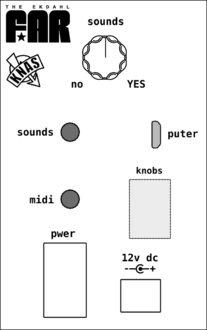The Ekdahl FAR - Getting started: Difference between revisions
No edit summary |
No edit summary |
||
| Line 9: | Line 9: | ||
There is also a mute that can be set to either being completely disengage from the string, freely do partial muting to suppress or exaggerate certain overtones, or to do full muting of the string. | There is also a mute that can be set to either being completely disengage from the string, freely do partial muting to suppress or exaggerate certain overtones, or to do full muting of the string. | ||
The overtone(s) to be emphasized are selected by [[The Ekdahl FAR - Getting started#harmonic number|harmonic number]]<nowiki/>s where harmonic 0 is the fundamental frequency of the string and all overtones are being calculated from this fundamental using the selected [[The Ekdahl FAR - Getting started#harmonic table|harmonic table]]. The default [[The Ekdahl FAR - Getting started#harmonic table|harmonic table]] is using just intonation in a 12-tone scale, thus harmonic 12 will be one octave above the fundamental, harmonic -12 will be on octave below etc. The effective range | The overtone(s) to be emphasized are selected by [[The Ekdahl FAR - Getting started#harmonic number|harmonic number]]<nowiki/>s where harmonic 0 is the fundamental frequency of the string and all overtones are being calculated from this fundamental using the selected [[The Ekdahl FAR - Getting started#harmonic table|harmonic table]]. The default [[The Ekdahl FAR - Getting started#harmonic table|harmonic table]] is using just intonation in a 12-tone scale, thus harmonic 12 will be one octave above the fundamental, harmonic -12 will be on octave below etc. The effective range available depends on the string tuning and the physical maximum and minimum speed of the bowing motor, generally a 3 to 4 octave range can be reached. | ||
== Terminology == | == Terminology == | ||
Revision as of 19:30, 16 January 2025
At a glance
To get started with the Ekdahl FAR there are a number of key concepts and other bits of information that you need to know, the instrument works on a principle quite unlike anything else thus to get the most out of it i implore you to take a few minutes and read this document.
The Ekdahl FAR should come calibrated to a standard set of parameters but even so, due to its acoustic nature, minor periodic maintenance is required. Most notably the instrument will have to be regularly fine tuned in order for the bowing of specific overtones to sound good, an out of tune instrument will not resonate.
The main ways of creating sound is by using the bowing wheel to precisely bow the string with a given speed, the speed of the bowing wheel determines which - if any - naturally occurring overtone(s) in the string is being emphasized. The pressure with which the bowing wheel is pressed up against the string will affect both loudness and harmonic content. One can also use the hammer to strike the string with a given force, the amount of force will affect both loudness and harmonic content. These modes can either be used separately or together.
There is also a mute that can be set to either being completely disengage from the string, freely do partial muting to suppress or exaggerate certain overtones, or to do full muting of the string.
The overtone(s) to be emphasized are selected by harmonic numbers where harmonic 0 is the fundamental frequency of the string and all overtones are being calculated from this fundamental using the selected harmonic table. The default harmonic table is using just intonation in a 12-tone scale, thus harmonic 12 will be one octave above the fundamental, harmonic -12 will be on octave below etc. The effective range available depends on the string tuning and the physical maximum and minimum speed of the bowing motor, generally a 3 to 4 octave range can be reached.
Terminology

- Bowing wheel - the wheel attached to the bowing motor, which is actually rubbing against the string
- Bowing jack - the assembly that holds the bowing motor and bowing wheel, this can be tilted up and down applying different pressure on the string
- Pressure - the positioning of the bowing jack. While the bowing wheel is touching the string this essentially sets the amount of force with which the bowing wheel is pressed against the string.
- Bow pressure position - sets one of the pre-defined bowing jack pressure positions where the rest position is where the bowing wheel is not touching the string at all, and engage is where it's starting to barely touch the string.
- Harmonic table - A list of ratios used to emphasize overtones in the string, each ratio corresponds to a MIDI or CV note in an octave. The default harmonic table contains 12 ratios per octave and the ratios are derived from just intonation.
- Harmonic / Harmonic number - a single ratio and octave in the current harmonic table. The ratio is used to calculate the bowing frequency from the fundamental, this frequency will emphasize a certain overtone. e.g. a harmonic number 17 in a 12-note scale refers to the 5th ratio on the second octave from the fundamental.
- Harmonic shift / fine tune - freely shifts the frequency of the bowing wheel from the harmonic number set. The command issued is dependent on the harmonic shift range which can be edited with the configuration utility.
- Control method - the method of control used. This can be CV, USB-MIDI, MIDI or USB-Serial as of the writing of this document.
- Command - the Ekdahl FAR is entirely controlled by internal commands, these decide what the instrument is doing and changes internal parameters. When a MIDI event occurs or a new CV / knob value is read, the commands associated with it will be sent to the instrument. This can be things like "engage hammer" or "set the fundamental frequency" etc. Some of the available commands are mainly used for calibrating and setting up the instrument and are usually saved into the instruments memory, these will be executed whenever the instrument is turned on. All commands can be manually invoked via USB-Serial.
The Front Panel

The front panel has all the basic connections required to interface with the Ekdahl FAR.
The 'sounds' jack is the main audio output and the volume is set with the 'sounds' knob, due to the fact that different strings will have a different output levels, the gain offered will make the sound distort if turned up too high at times. Care should be taken to find a good balance in between noise floor and the possibility of the sound distorting.
The 'MIDI' jack is a TRS 3.5mm Type A jack as adopted by the MIDI standard.
The 'puter' jack is the USB connection and works in device mode, when connected to a USB host it presents itself as a USB-MIDI device and a USB-Serial device.
The 'knobs' jack currently only connects to the Control Box, this is however configured as a versatile port that may interface with other - future - control surfaces and interfaces.
The '12v dc' jack is the main power for the Ekdahl FAR, it currently requires a center-positive 12V DC supply at 2 amps.